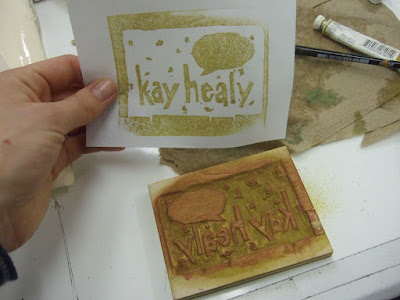
In class on Thursday I went over a quick Japanese woodblock carving and printing demo. After playing around with some of the tools from Baren Mall on scrap pieces of wood from McClain's, I showed everyone how to print a simple woodblock.

After soaking the blocks in water for a few minutes, you add a few drops of watercolor mixed with Nori (rice paste) to the block.

Next you use this traditional brush to spread the ink evenly across the block.

You then lay your hoshi printing paper over the block. Ideally your paper would be decanted in a plastic bag with spritzed newsprint in between each sheet of hoshi.

With freezer or wax paper on top, you use a barren to place even strokes of pressure across the paper.

Then you peel off your print!

Many of the students also printed their collograph plates. Nate made many blind embossments of the above plate.

This is Jamie's colorful collograph.

Nate and Jamie in action.














